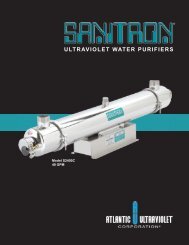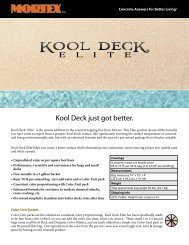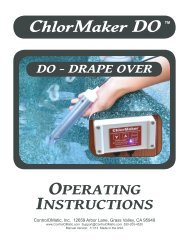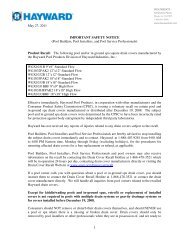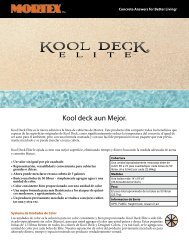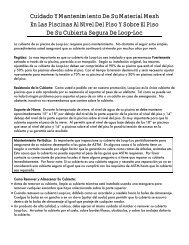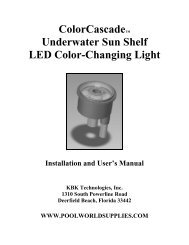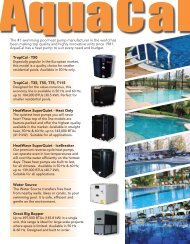Horizontal Sand Filter Brochure
Horizontal Sand Filter Brochure
Horizontal Sand Filter Brochure
Create successful ePaper yourself
Turn your PDF publications into a flip-book with our unique Google optimized e-Paper software.
3.2 <strong>Filter</strong> Installation<br />
Move the filter(s) into place by mechanical means if possible. Be careful not to hit the filter against something<br />
solid while positioning. Before continuing, be sure that the filter(s) is in the desired location with the<br />
connections facing the direction necessary for proper installation. It is also very important to make sure that<br />
the filter is sitting on a level hard surface.<br />
It is possible that during transportation, some of the internal components have loosened. It is now necessary to<br />
remove the filter lid and enter the filter, being careful not to break any of the connections. By hand, check the<br />
tightness of all the laterals in the bottom of the filter making sure they are firmly tightened. Also, while in the<br />
filter, check for any cracks or breaks in the body of the filter or the PVC internals that might have occurred during<br />
transportation using a flashlight.<br />
Inside the components box that is included with the filter there are two ¾” ball valves and gaskets for them.<br />
Install these valves with the gaskets onto the filter. One is for the top air purge nozzle located between the port<br />
connections. The second is located below the manhole and above the base of the filter.<br />
3.3 Valve manifold and supports installation<br />
There are many different styles of manifolds that are available: 4 valve, 5 valve, single filter, dual filter, triple<br />
filter, and automatic for each style. If the manifold is purchased with the filter, it will come with a specific set<br />
of installation instructions inside the box. These instructions will cover all necessary steps to installing the<br />
manifold.<br />
3.4 Testing of filter<br />
Before adding any sand to the filter, it is very important to test the system with water only!!! All filters are<br />
tested with high pressure before leaving the factory. It is possible that during transportation, the filter was damaged.<br />
It can be difficult to see some types of damages that may have occurred. It is important to test the system<br />
without sand first to check for leaks. Fill the system with water and then replace the lid and gasket. Run<br />
system as normal and check of leaks. If there is a problem with the test, contact customer service immediately.<br />
If sand is added before the test and there is a problem with the filter, the sand will need to be evacuated<br />
for inspection. The manufacturer will not pay for the removal and replacement of the sand for warranty or repair<br />
work, nor the labor to evacuate and replace the sand for repair work done due to transportation. This is<br />
also a good chance to check all of the plumbing for the system. Do not drain the water from the filter after<br />
the testing sequence.<br />
3.5 Installation of the media<br />
After the testing has been finished and the system is 100% operational, we need to add the filtration media required.<br />
Remove the lid and gasket from the filter as before. The filter should be full of water at this time. If<br />
the filter is not full of water, the filter needs to be filled at least to the diffusers before adding the media.<br />
Add the required amount of #20 silica sand to the filter. Now, replace the lid and gasket to the top of the filter.<br />
Be sure that the manhole cover is free of sand. If this is not free of sand, the gasket will not seat properly and<br />
could cause the filter to leak at the lid.<br />
Put the filter into backwash mode and run for about 5 to 6 minutes. This will level the sand inside the filter and<br />
will also remove the dust from the sand directly to waste. Put the valves into filter position and the system is<br />
ready for operation.



